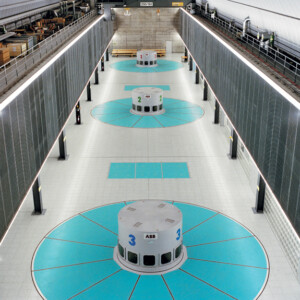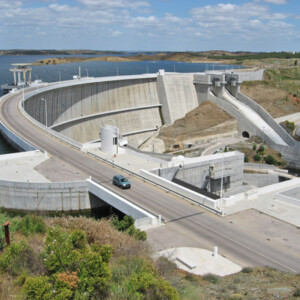Flexibility, technologies and scenarios für hydropower
Report Summary: This report by the European Union (EU)-funded XFLEX HYDRO project explores the emerging opportunities for hydropower plants to provide new short-term flexibility and system support services, known as ancillary services, to the European grid. Over the next two years, XFLEX HYDRO’s technological solutions and performance enhancements will be implemented in the project’s demonstration programme. This will allow the expected improvements in ancillary services and KPIs to be evaluated, using the matrices as reporting frameworks.







Flexible energy sources, such as hydropower, are increasingly important to balance the growing amount of variable renewable energy (VRE) sources, primarily wind and solar power, in the European grid. In addition, the decarbonisation of the grid is leading to the decommissioning of fossil-fuel power plants. This is reducing the capacity of grid operators to provide regulating power to the grid to ensure the continuous load-generation balance necessary for grid stability. XFLEX HYDRO is an ambitious €18 m energy innovation project demonstrating how more flexible hydro assets can help countries and regions to meet their renewable energy targets. The four-year project involves 19 organisations and is focused on seven demonstration sites across Portugal, France and Switzerland. It will conclude in 2023 with policy and market recommendations.
More variable renewables will require more flexibility in the grid
On the path to decarbonisation, dramatic increases in variable renewable energy production are expected to cause much higher volatility in the electricity system. Grid operators must constantly balance demand with supply to keep the system stable, and the growing levels of variability from wind and solar generation will increase the complexity of this challenge. In this context, there will be a greater need for flexible and controllable supply from low-carbon sources.
As a low-carbon, renewable, flexible energy source, hydro will play a key role in decarbonisation
Hydropower will have a leading role in managing the growing need for flexibility in the power grid. It can provide large quantities of both capacity (short-term power flexibility) and energy (medium-term and longterm power and energy flexibility). Hydropower occupies a unique position because it can store primary energy (GWh) with high efficiency as the potential energy of water. Importantly, it can also provide power capacities (GW) at a high degree of predictable availability. These
advantages become increasingly significant as fossil-fuel thermal units are phased out. Other interventions, such as stationary batteries, electric vehicles and demandresponse, will also contribute solutions but in a less predictable way. This changing energy mix is leading to shifts in power markets.
The changing energy mix is creating new markets for services required to ensure grid stability
The expected requirement for new short-term flexibility and system support services, known as ancillary services, is reflected in new market frameworks for their deployment, exchange and remuneration. XFLEX HYDRO has assessed the future ancillary services envisioned by transmission system operators (TSOs) in the Continental Europe (CE) synchronous area (SA) and the related technical requirements for these services. The existing or anticipated market for each service has also been considered. The following ancillary services have been identified as relevant to the project:
• Synchronous inertia: is the inherent capability of rotating machines directly connected to the power grid to store and inject their kinetic energy to support the electrical system. The level of inertia directly influences the rate of change of frequency (RoCoF) that occurs immediately after an active power imbalance. Synchronous inertia may be obtained by increasing the rotating mass connected to the system, which includes turbinegenerating and pumping units as well as synchronous condensers. The service is not currently remunerated in CE but is starting to be contracted by TSOs under specific tenders, as is the case in the UK.
• Synthetic inertia: power electronic-interfaced energy sources can provide short-term frequency support through proper control of the coupling interface. While not providing synchronous inertia, they are able to swiftly adapt power output, driven by their control system, to provide synthetic inertia; assuming there is an energy buffer available within the primary energy source. For example, in the rotating mass and stored kinetic energy of a wind turbine. Synthetic inertia requires the frequency to be measured and processed for control purposes, meaning its effect on the grid has a very short delay (less than 500 milliseconds) and is of small duration in time, depending on the stored energy existing in the energy buffer. Although not foreseen in the short to medium term to be a remunerated service in CE, it will likely start to become mandatory or contracted in tendering markets given the expected growth in power electronics-based renewables such as solar PV that will feed the system.
• Fast Frequency Response (FFR): is designed to provide an active power response faster than existing operating reserves, typically in less than two seconds in the timeframe following inertial response and before activation of FCR (see below). Although not yet defined or rewarded as a service in CE, FFR is already being explored in markets such as the UK (previously tendered as Enhanced Frequency Response or EFR), the Irish and the Nordic markets.
• In CE, emerging trends in balancing services are starting to be implemented based on the EU Electricity Balancing Guideline (EBGL), and subsequent exchange platforms/projects, in terms of the following:
• Frequency Containment Reserve (FCR) (which in original terminology is known as primary frequency control): aims to contain system frequency after an active power imbalance, by maintaining the balance
between active power generation and demand within a synchronous area, aiming to comply with pre-defined frequency metrics. An FCR response must be fully activited within 30 seconds. FCR is already exchanged in the FCR Cooperation platform of Central Europe.
• Automatic Frequency Restoration Reserve (aFRR) (in original terminology aligned with secondaryfrequency control): aims to restore the Area Control Error (ACE, also named Frequency Restoration Control
Error – FRCE) of each Load-Frequency Control area toward zero. In other words, it aims to restore the system frequency back to its set point (normal) value and/or keep the power interchange program among LFC areas. aFRR is a remunerated product being traded in specific platforms managed by TSOs, which are automatically implemented with initial activation in less than 30 seconds, and full activitation within 15 minutes. This service already has a standard product defined to be traded in the aFRR platform under the PICASSO initiative as well as in the IN process related to the International Grid Control Cooperation (IGCC).
• Manual Frequency Restoration Reserve (mFRR) and Replacement Reserve (RR) (in the original terminology called tertiary frequency control): mFRR is a manually controlled Frequency Restoration Reserve service that must be fully activated in 15 minutes, while Replacement Reserve (RR) then aims to progressively replace or support the frequency restoration control process. The RR services follow optional TSO instructions for manual activation of reserves in the affected grid area, usually in a timeframe between 15 minutes and one hour. These services also have standard products defined, which are to be exchanged in the common platforms of the Manually Activated Reserves Initiative (MARI) and Trans European Replacement Reserves Exchange (TERRE) respectively.
• Voltage/reactive power control (Volt/var): is a local technical issue, which is now typically mandatory and not remunerated. The volt/var control process is implemented by manual or automatic control actions designed to maintain the nominal set values for the voltage levels and/or reactive powers. Usually, there are also bilateral contracts held between a service provider and TSO for the provision of extra volt/var control.
• Black start: is the capability of restarting operation of a power plant during a grid blackout, from a complete shutdown and island-operating state of the plant, without any power feed from the network. The service is intended to power up other plants and loads, and aims to bring the grid system back to normal operating conditions. Black start is today contracted through bilateral agreements and is not expected to have its own market framework in future.
XFLEX HYDRO is demonstrating technological solutions to enhance hydroelectric power plants capacity to contribute to grid flexibility
XFLEX HYDRO’s goal is to demonstrate innovative hydropower solutions to maximise hydroelectric power plants (HPPs) performance and increase their contribution to grid flexibility. These technologies are being assessed in detail across seven demonstration sites in Portugal, France and Switzerland. The demonstrations will enable a better understanding of the technical and economic benefits, as well as the challenges, of each solution. Demonstration results will inform recommendatoins for their wider application in Europe. The solutions are:
• Digitalisation tools (Smart Power Plant Supervisor): using plant health monitoring and data capture to reduce maintenance needs and plant outage time; while also increasing efficiency and helping to minimise stresses on equipment under increased flexible operation. This will ultimately support hydro plant operators in their decision-making regarding the provision of flexibility services to the grid.
• Integration of advanced control for battery storage system: hybridising a battery storage system at a runof-river hydro power plant, with the aim of providing extended flexibility and fast response services to the grid and increasing plant availability.
• Integration of Pumping and Generating Power regulation using Hydraulic Short Circuit (HSC): through the tandem operation of the pumping and generating modes, HSC can enhance the power regulation services and operating ranges offered by pumped storage plants.
• Integration of Doubly Fed Induction Machine (DFIM) variable-speed technology: aiming to extend operating range and add flexibility capabilities for the grid, while also improving annual efficiency and residual lifetime. Enhancing the power regulation range by running DFIM in HSC mode will be also assessed.
• Integration of Full-Size Frequency Converter (FSFC) variable-speed technology: upgrading hydropowerpotential by integrating FSFC variable-speed technology, using its high flexibility capability and enhanced functionalities for plant operation.
A framework represented by an Ancillary Services Matrix will
show XFLEX HYDRO’s expected technological improvements
A comprehensive framework has been developed to evaluate XFLEX HYDRO’s technologies and improvements. This is presented in an Ancillary Services Matrix, which sets out the services required by the future power system (as defined by the project), the corresponding markets and the technologies being demonstrated. The Matrix will help inform stakeholders in the industry of the emerging opportunities for HPPs in relation to these ancillary services and provides a reporting framework for the project. The first stage of the Matrix presents the baseline case, i.e. how the demonstrations currently perform against each type of ancillary service, and how these services relate to market frameworks. In each case, coloured circles are used in the cells to score the capability of the current (baseline case) for the services identified. As the project progresses, the Matrix will be updated.
Future energy scenarios will help to inform modelling of XFLEX HYDRO’s solutions at system-scale
Building on the assessment of services and markets, future scenarios of the power generation mix in Europe have been considered to understand the annual energy generation mix (in TWh) and the installed capacity mix (in GW) for 2025, 2030 and 2040. These future scenarios will help to inform modelling of XFLEX HYDRO’s solutions at system-scale.Future scenarios published by the European Network of Transmission System Operators (ENTSO-E), suggest that hydropower capacity (including pumped storage) could increase to approximately 280 GW by 2040 under its National Trends scenario. This indicates the market potential for the flexibility technologies and methods being demonstrated in XFLEX HYDRO, at both new hydro plants as well as existing facilities, could be significant.
A Key Performance Indicators Matrix will also capture improvements in plant operations and maintenance
The Ancillary Services Matrix will show the gains of the demonstrations in supporting the provision of ancillary services. However, XFLEX HYDRO activities also aim to strengthen the plants flexibility, by optimising operations and maintenance. For this, several Key Performance Indicators (KPIs) have been defined to quantify the HPPs flexibility, focusing on the enhancement of operations and maintenance. This is being presented in a KPIs Matrix, which is currently under development. Next steps: Over the next two years, XFLEX HYDRO’s technological solutions and performance enhancements will be implemented in the project’s demonstration programme. This will allow the expected improvements in ancillary services and KPIs to be evaluated, using the matrices as reporting frameworks.
